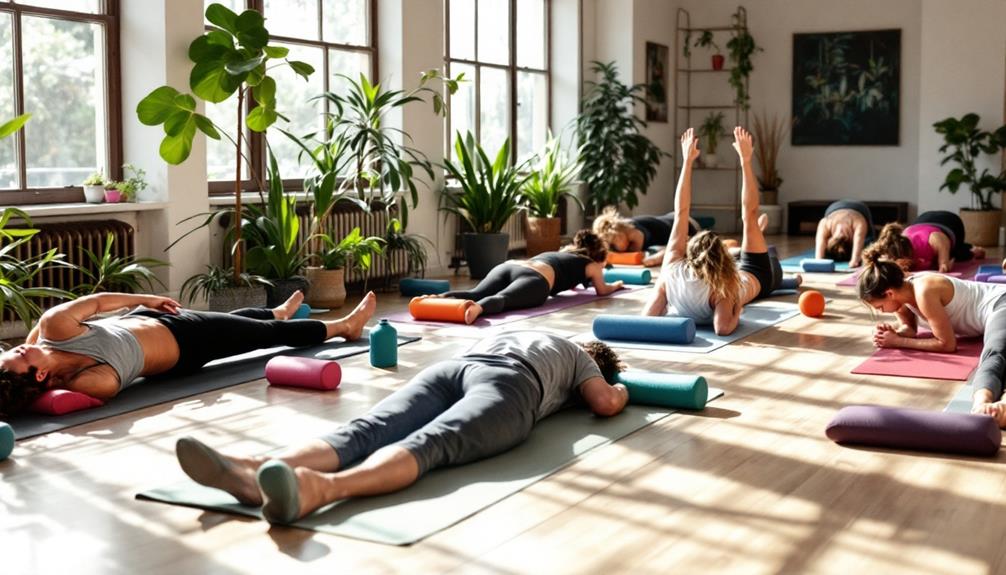To integrate active recovery workouts into your fitness routine, start by scheduling at least one session weekly. These sessions can include low-impact activities like walking, cycling, or yoga. Aim to keep the intensity low to promote blood flow and help your muscles recover. Listen to your body and adjust the timing based on your workout intensity. Focus on hydration and nutrition to support recovery. Treat these sessions as important appointments, not just optional extras. This balance can help reduce soreness and stress, enhancing your overall performance. You might discover even more effective strategies for your active recovery journey.
Core Insight
- Schedule at least one active recovery session each week to prioritize muscle healing and overall fitness.
- Incorporate low-impact activities like walking, yoga, or cycling on lighter workout days for optimal recovery.
- Listen to your body and adjust recovery days based on workout intensity and soreness levels.
- Stay consistent with recovery sessions, treating them as essential appointments in your fitness routine.
- Maintain hydration and a balanced diet to support your active recovery efforts effectively.
Understanding Active Recovery

Active recovery is about helping your body recover while still staying active. It involves doing low-impact activities that boost blood flow and support muscle healing. Instead of working out hard every day, try gentle exercises like walking, cycling, or yoga. These activities keep your body moving and help your muscles recover from tougher workouts.
Using compression sleeves during active recovery can improve blood flow and support certain muscle groups, making recovery even better. It's important to understand that active recovery is not about pushing yourself. It's about taking care of your body.
Benefits of Active Recovery

One big benefit of adding active recovery to your routine is that it improves blood circulation. Better circulation helps deliver oxygen and nutrients to your muscles, which speeds up recovery. You may also experience less muscle soreness, keeping you motivated for your next workout. Active recovery is especially helpful for recovering from injuries and reducing inflammation, much like cold therapy compression wraps.
Active recovery also helps lower stress levels and encourages relaxation. By doing light activities like walking or gentle cycling, your body can recover without adding extra strain. This is a great way to stay fit while giving your muscles a rest.
Key Principles to Follow

To add active recovery to your fitness routine, it's important to follow some key principles. First, listen to your body. Notice how you feel after tough workouts; this will help you decide when to take recovery days. Next, mix things up. Try different activities like walking, cycling, or yoga to keep your routine fun and effective. Cooling towels can also help during your low-intensity sessions by keeping you comfortable. Remember, keep the intensity low; the aim is to boost circulation without adding more stress.
Stay hydrated and eat well to support your recovery. Make sure to schedule these sessions into your week, treating them as important as your high-intensity workouts. By following these simple principles, you'll improve your overall fitness and well-being.
Types of Active Recovery Workouts

Incorporating different types of workouts into your active recovery routine can boost your overall fitness. Here are some effective options to consider:
Walking
A simple walk can help increase blood flow and reduce stiffness. Try to walk for 20-30 minutes at a comfortable pace.
Yoga
Gentle yoga improves flexibility and encourages relaxation. Focus on poses that stretch your major muscle groups.
Swimming
Swimming is a low-impact way to work your entire body without stressing your joints. A leisurely swim can be both refreshing and restorative.
Cycling
Light cycling, whether indoors or outdoors, helps maintain your cardiovascular fitness without putting too much strain on your body.
Foam Rolling
Foam rolling helps relieve muscle tightness and supports recovery. Spend a few minutes rolling out any sore areas. Using high-density foam rollers can provide firm pressure for a deep tissue massage, helping your muscles recover and improving blood flow. You can also try textured foam rollers for targeted relief on specific muscle groups.
Creating Your Weekly Schedule

To incorporate active recovery workouts into your routine, it's important to create a balanced weekly schedule. Start by looking at how often and how intensely you currently work out. Aim to have at least one active recovery session each week, especially after your more intense workouts. You might consider using compression sleeves to support specific areas during recovery, which can help improve performance, especially for activities like running or strength training.
Plan these recovery sessions on lighter workout days or right after strength training days. Good options for recovery include yoga, walking, or swimming.
Next, set aside specific times in your calendar for these activities. Consistency is important, so treat these sessions like important appointments you can't miss.
Listening to Your Body

Listening to your body is key to making the most of your active recovery workouts. It helps you know when to push yourself and when to take a break. Pay attention to what your body is telling you, and don't ignore those signals. Staying hydrated is important during active recovery, and electrolyte gummies can help keep your fluids balanced. Here are some signs to watch for:
- Fatigue: If you feel more tired than usual, it may be time to slow down.
- Soreness: Ongoing soreness might mean you need extra recovery time.
- Mood Changes: If you feel irritable or unmotivated, take that as a sign to rest.
- Sleep Quality: Difficulty sleeping can indicate that your body needs a break.
Incorporating Flexibility and Mobility

Listening to your body is key to making flexibility and mobility a priority in your recovery routine. Adding stretching exercises can boost your performance and lower the risk of injuries. Before workouts, focus on dynamic stretches, and save static stretches for after.
Using high-density foam rollers is a great way to massage your muscles and relieve tension. They apply targeted pressure to help you feel better. You might also want to try yoga or Pilates a few times a week. These activities can help you move better and relax.
Foam rolling is another effective choice; it eases muscle tightness and improves blood flow.
Try to spend at least 15-20 minutes on these activities a few times a week. Pay attention to what your body needs, and adjust how hard and how long you do these exercises. By focusing on flexibility and mobility, you'll aid your recovery and enhance your overall fitness journey.
Fun Active Recovery Activities

Active recovery can be enjoyable! There are many fun activities that can help you recover while keeping you engaged. When you choose activities you like, you can feel happier and more refreshed. To stay comfortable while doing these activities, consider using cooling towels to help manage your body temperature. Here are some fun options to try:
- Walking in nature: Take a stroll outdoors and enjoy the fresh air and beautiful sights.
- Light cycling: Ride your bike at an easy pace to let your muscles recover without putting them under stress.
- Yoga: Practice gentle poses that help improve flexibility and relaxation.
- Dancing: Move to your favorite music and have a great time.
These activities can make your recovery process enjoyable and effective. So get out there and have some fun while you recover!
Monitoring Progress and Adjustments
Tracking your progress during active recovery workouts is important for your recovery and fitness journey. Start by setting clear and measurable goals. This could be how long you exercise or how you feel after your workouts. Use a journal or an app to keep track of your workouts, noting any changes in your energy levels or soreness. If you're in a hot climate, consider using salt pills to help with hydration and maintain your electrolyte balance during these sessions. This can help prevent dehydration and support your overall performance.
Next, check in on your progress regularly. Are you feeling more energized? Is your recovery time getting shorter? If you see no change, it might be time to adjust your routine. You can try new activities or slightly increase the intensity.
Frequently Asked Questions
Can Active Recovery Workouts Replace Traditional Rest Days?
While the sirens of constant activity call, you shouldn't overlook traditional rest days. Active recovery workouts can complement your routine, but they can't fully replace the restorative benefits of true rest for best recovery and performance.
How Long Should Active Recovery Sessions Last?
Active recovery sessions should typically last between 20 to 60 minutes. You'll want to listen to your body and adjust the duration based on how you feel, ensuring you're still allowing for proper recovery.
What Should I Eat Before and After Active Recovery Workouts?
Imagine devouring a feast fit for a champion! Before your active recovery, munch on a light snack like yogurt or fruit. After, savor a protein-packed meal to fuel your muscles and keep them happy.
Is Active Recovery Suitable for Beginners?
Yes, active recovery is suitable for beginners. It helps you ease into fitness, promotes blood flow, and reduces soreness. Just listen to your body, start slow, and gradually increase intensity as you gain confidence.
Can I Do Active Recovery on My Strength Training Days?
Studies show that 70% of athletes benefit from active recovery on strength training days. You can definitely incorporate it; light activities like walking or yoga help reduce soreness and improve performance, keeping you on track with your goals.

